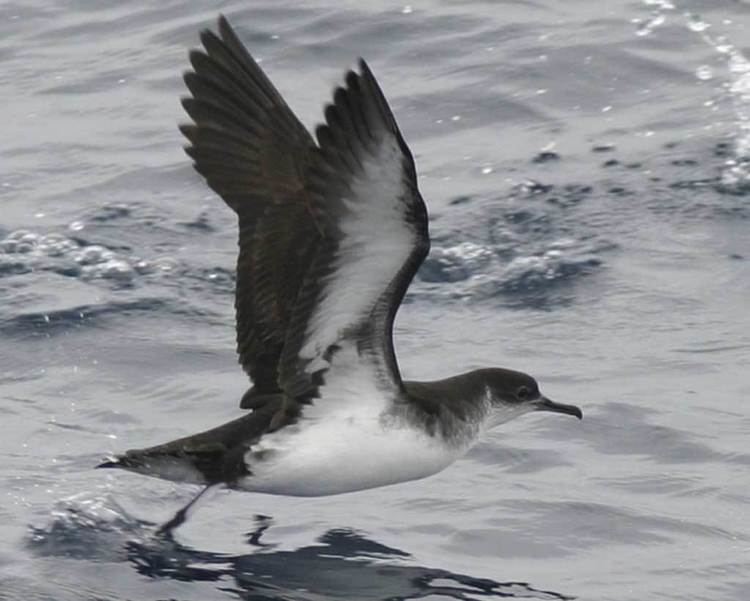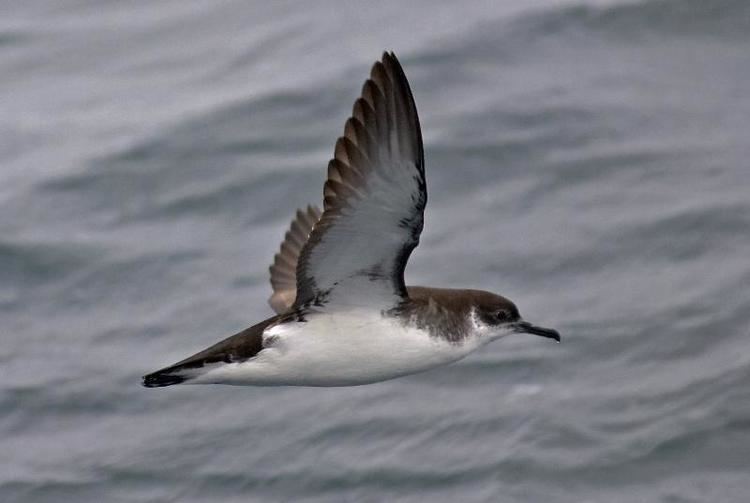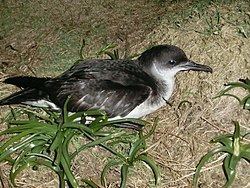Higher classification Puffinus | Phylum Chordata Scientific name Puffinus puffinus Rank Species | |
 | ||
Similar Bird, Puffinus, Sooty shearwater, Great shearwater, Storm petrel | ||
Skomer island nightlife manx shearwater calls
The Manx shearwater (Puffinus puffinus) is a medium-sized shearwater in the seabird family Procellariidae. The scientific name of this species records a name shift: Manx shearwaters were called Manks puffins in the 17th century. Puffin is an Anglo-Norman word (Middle English pophyn) for the cured carcasses of nestling shearwaters. The Atlantic puffin acquired the name much later, possibly because of its similar nesting habits.
Contents
- Skomer island nightlife manx shearwater calls
- Manx shearwater isle of man dslr video
- Taxonomy
- Description
- Voice
- Vision
- Range and habitat
- Behaviour
- Breeding
- Food and feeding
- Predators and parasites
- Status
- In culture
- Cited texts
- References

Manx shearwater isle of man dslr video
Taxonomy

The shearwaters form part of the Procellariidae family, a widespread group containing nearly 100 species of medium to large seabirds. They have long, narrow wings and the characteristic “tubenose”. The large genus Puffinus includes several species formerly considered to be subspecies of the Manx shearwater, including the yelkouan shearwater, Balearic shearwater, Hutton's shearwater, black-vented shearwater, fluttering shearwater, Townsend's shearwater and the Hawaiian shearwater. Of these, the Hawaiian and possibly Townsend's shearwaters seem to be most closely related to the Manx shearwater.

Three extinct species appear to be closely related to the Manx shearwater, the lava shearwater, the dune shearwater and Scarlett's shearwater. DNA recovered from the lava shearwater of the Canary Islands suggests that it is the Manx shearwater’s sister species despite being significantly smaller.

The Manx shearwater was first described by Danish zoologist Morten Thrane Brünnich as Procellaria puffinus in 1764. The current scientific name Puffinus derives from "puffin" and its variants, such as poffin, pophyn and puffing, which referred to the cured carcass of the fat nestling of the shearwater, a former delicacy. The original usage dates from at least 1337, but from as early as 1678 the term gradually came to be used for another seabird, the Atlantic puffin. The current English name was first recorded in 1835 and refers to the former nesting of this species on the Isle of Man.
Description

The Manx shearwater is 30–38 cm (12–15 in) with a 76–89 cm (30–35 in) wingspan and weighs 350–575 g (12.3–20.3 oz). It has the typically "shearing" flight of the genus, dipping from side to side on stiff wings with few wingbeats, the wingtips almost touching the water. This bird looks like a flying cross, with its wing held at right angles to the body, and it changes from black to white as the black upperparts and white undersides are alternately exposed as it travels low over the sea.
Voice
This shearwater is mainly silent at sea, even when birds are gathered off the breeding colonies. It calls on its nocturnal visits to the nesting burrows in flight, on the ground and in the burrows, although moonlight depresses the amount of calling. The vocalisations largely consists of a raucous series of croons, howls and screams, typically in groups of 4–5 syllables which become weaker and throatier. The male has some clear ringing and shrieking tones absent from the harsher repertoire of the female, the difference being obvious when a pair duets. Females can recognise the voice of their mate, but not of their young. They do not provide post-nesting care, and it is likely that a chick in the burrow is their own, so there is no need for voice identification.
Vision
The vision of the Manx shearwater has a number of adaptations to its way of life. Like other tubenosed seabirds it has a long narrow area of visual sensitivity containing the fovea across the retina of the eye. This region is characterised by the presence of ganglion cells which are regularly arrayed and larger than those found in the rest of the retina. This feature helps in the detection of items in a small area projecting below and around the bill. It may assist in the detection of prey near the sea surface as a bird flies low over it.
Since it visits its breeding colonies at night, a shearwater has adaptations for nocturnal vision too. In the shearwater's eyes the lens does most of the bending of light necessary to produce a focused image on the retina. The cornea, the outer covering of the eye, is relative flat and so of low refractive power. In a diurnal bird like a pigeon, the reverse is true; the cornea is highly curved and is the principal refractive component. The ratio of refraction by the lens to that by the cornea is 1.6 for the shearwater and 0.4 for the pigeon. The shorter focal length of shearwater eyes give them a smaller, but brighter, image than is the case for pigeons. Although the Manx shearwater has adaptations for night vision, the effect is small, and it is likely that these birds also use smell and hearing to locate their nests.
Range and habitat
The Manx shearwater is entirely marine, typically flying within 10 m (30 ft) of the sea surface. It nests in burrows on small islands which it visits only at night. Its nesting colonies are in the north Atlantic Ocean in the United Kingdom, Ireland, Iceland, the Faroe Islands, France, the Isle of Man, the Channel Islands, the Azores, Canary Islands and Madeira. The most important colonies, with a total of more than 300,000 pairs, are on islands off Wales, Scotland and Northern Ireland. Three-quarters of the British and Irish birds breed on just three islands; Skomer, Skokholm and Rùm. Around 7000–9000 pairs breed in Iceland with at least 15,000 pairs on the Faeroes. Other populations are of at most a few hundred pairs. The north east of North America has recently been colonised from Newfoundland and Labrador to Massachusetts; although breeding was first recorded in 1973, populations remain small. Records in the northeast Pacific are increasing, and breeding has been suspected in British Columbia and Alaska.>
The breeding colonies are deserted from July to March when the birds migrate to the south Atlantic, wintering mainly off Brazil and Argentina with smaller numbers off southwest South Africa. The journey south can be over 10,000 km (6,000 mi), so a 50-year-old bird has probably covered over a million km (600,000 mi) on migration alone. The migration also appears to be quite complex, containing many stopovers and foraging zones throughout the Atlantic Ocean. Ornithologist Chris Mead estimated that a bird ringed in 1957 when aged about five years and still breeding on Bardsey Island off Wales in April 2002 had flown over 8 million km (5 million mi) in total during its 50-year life.
Manx shearwaters are able to fly directly back to their burrows when released hundreds of kilometres away, even inland. They are able to detect the Earth's magnetic field and hence navigate back to their colonies. The details of how birds interpret the magnetic data are not fully understood, but tiny crystals of magnetite around the eye are involved in detecting the field.
Behaviour
Manx shearwaters are long-lived birds. A Manx shearwater breeding on Copeland Island, Northern Ireland, was as of 2003/04 the oldest known living wild bird in the world: ringed as an adult (at least 5 years old) in July 1953, it was retrapped in July 2003, at least 55 years old.
This is a gregarious species, which can be seen in large numbers from boats or headlands, especially on migration in autumn. It is silent at sea, but at night the breeding colonies are alive with raucous cackling calls.
Breeding
Although shearwaters return to the breeding colonies from March onwards, the females often then leave again for a two or three weeks before egg-laying in early May. Males return to the colonies in which they were hatched, but up to half of females may move elsewhere. The nest is a burrow, often previously excavated by a European rabbit, although shearwaters can dig their own holes. Suitable holes under rocks may also be used. The burrows may be reused in subsequent years.
The single white egg averages 61 x 42 mm (2.4 x 1.7 in) and weighs 57 g (2.0 oz) of which 7% is shell.
Food and feeding
The Manx shearwater feeds on small fish (herrings, sprats and sand eels), crustaceans, cephalopods and surface offal. The bird catches food off the surface or by pursuit diving, and forages alone or in small flocks. It can be attracted by feeding cetaceans, but rarely follows boats or associates with other shearwater species.
Tubenosed seabirds can detect food items at a distance of several tens of kilometres using their sense of smell to detect offal and compounds such as dimethyl sulfoxide produced when phytoplankton is consumed by krill. They track across the wind until they find a scent and then follow it upwind to its origin.
Predators and parasites
Because of their lack of mobility on land, Manx shearwaters are vulnerable to attack by large gulls, such as the great black-backed gull, and great skua. Birds of prey such as the peregrine falcon and golden eagle are also recorded as killing adult birds.
Rats and cats are a serious problem where they are present; the large shearwater colony on the Calf of Man was destroyed by rats which arrived from a shipwreck. European hedgehogs eat the eggs of nesting seabirds where they have been introduced. Red deer have been recorded killing and eating young shearwaters on at least Foula, Skokholm and Rùm; on the latter island, 4 percent of the chicks are killed by deer, and sheep have also been involved. The reason for the carnivorous behaviour is thought to be a need for extra calcium.
Manx shearwaters frequently carry feather lice (Mallophaga) most of which either the feather-eatiers in the groups ischnocera, or Amblycera which also consume blood. The commonest are the Ischnocerans Halipeurus diversus and Trabeculus aviator. The nests of breeding birds frequently contain the shearwater flea Ornithopsylla laetitiae is also commonly present, which shares a common ancestry with North American rabbit fleas. Where their burrows are near those of Atlantic puffins, the tick Ixodes uriae is common. The mite Neotrombicula autumnalis is often present, and has been implicated in spreading puffinosis. Puffinosis is a virus disease of in which young birds get blisters on their feet, conjunctivitis and problems with movement. The death rate can reach 70% in infected birds. Internal parasites include the tapeworm Tetrabothrius cylindricus.
Status
The European population of the Manx shearwater has been estimated at 350,000–390,000 breeding pairs or 1,050,000–1,700,000 individual birds and makes up 95% of the world total numbers. Although this species' population now appears to be declining, the decrease is not rapid or large enough to trigger conservation vulnerability criteria. Given its high numbers, this shearwater is therefore classified by the International Union for Conservation of Nature as being of least concern.
In the north of its range, numbers are stable and the range is expanding, but human activities are affecting populations in the Macaronesian islands. These include birds stranded when dazzled by artificial lighting. 1000–5000 chicks a year are legally taken for food in the Faroes. Introduced mammals are a problem, although populations can recover when rats and cats are removed from islands. Rabbits may try to occupy burrows, but also dig new tunnels.
In culture
The large chicks of the Manx shearwater are very rich in oil from their fish diet and have been eaten since prehistoric times. They are easily extricated from their burrows, and the annual crop from the Calf of Man may have been as high as 10,000 birds per year in the seventeenth century. The young birds were also eaten in Ireland, Scotland and the Scottish islands.
The eerie nocturnal cries of nesting shearwaters and petrels has led to associations with the supernatural. The breeding colonies at Trollaval on Rùm and Trøllanes and Trøllhøvdi in the Faroe Islands are believed to have acquired their troll associations from the night-time clamour.
